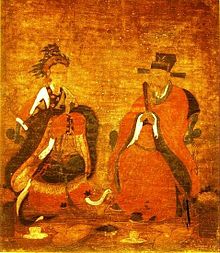Princess Noguk
 From Wikipedia the free encyclopedia
From Wikipedia the free encyclopedia
| Princess Supreme of Noh State 노국대장공주 魯國大長公主 | |||||||||||||
|---|---|---|---|---|---|---|---|---|---|---|---|---|---|
 Portrait of Princess Noguk and her husband, King Gongmin | |||||||||||||
| Queen consort of Goryeo | |||||||||||||
| Tenure | 1351–1365 | ||||||||||||
| Coronation | 1351 | ||||||||||||
| Predecessor | Queen Consort Yun | ||||||||||||
| Successor | Queen Consort Yi | ||||||||||||
| Born | Borjigin Budashiri Yuan dynasty | ||||||||||||
| Died | 8 March 1365 Goryeo | ||||||||||||
| Burial | Jeongneung Tomb, Haeseon-ri, Gaepung-gun, North Hwanghae Province | ||||||||||||
| Spouse | |||||||||||||
| Issue | Unnamed son (died afterbirth) | ||||||||||||
| |||||||||||||
| House | Borjigin (by birth) House of Wang (by marriage) | ||||||||||||
| Father | Bayir Temür | ||||||||||||
| Religion | Buddhism | ||||||||||||
| Princess Noguk | |
| Hangul | |
|---|---|
| Hanja | |
| Revised Romanization | Noguk Daejang Gongju |
| McCune–Reischauer | Noguk Taejang Kongju |
| Budashiri (Mongolian) | |
| Hangul | 부다시리 |
| Revised Romanization | Budasiri |
| McCune–Reischauer | Pudasiri |
| Budashiri (Korean) | |
| Hangul | 보탑실리 |
| Hanja | |
| Revised Romanization | Botapsilli |
| McCune–Reischauer | Pot'apsilli |
Princess Supreme Noguk (Korean: 노국대장공주; Hanja: 魯國大長公主; lit. Princess-Aunt of the State of No; d. 8 March 1365[a]), also known as Queen Indeok (인덕왕후; 仁德王后) and Queen Mother Indeok (인덕태후; 仁德太后) during her stepson, King U of Goryeo's reign. She was a Yuan dynasty imperial family member as the great-granddaughter of Darmabala, and a niece of Princess Joguk who became a Korean queen consort though her marriage with Gongmin of Goryeo as his primary wife. Her personal name was Borjigin Budashiri (Mongolian: Будшир; Middle Mongolian: ᠪᠤᠳᠢᠰᠢᠷᠢ; Chinese: 寶塔實里 or Chinese: 寶塔失里). She was the last Mongol to become queen consort of Goryeo.
Biography[edit]
The future Princess Noguk was born Budashiri, a member of the Yuan dynasty's ruling Borjigin clan and a great-great-great-granddaughter of Kublai Khan. Though her birth year is unknown, she is recorded as having married the reformist monarch Gongmin of Goryeo in the Yuan capital of Khanbaliq in 1349, after which she went to live in Goryeo.
Noguk's marriage followed a practice established by Kublai Khan, where female members of the Yuan imperial clan were married to Goryeo princes in order to maintain Yuan hegemony on the Korean peninsula.[1] By contrast with earlier marriages between the Yuan and Goryeo dynasties, however, Budashiri's marriage to Gongmin was described as happy[1] and after her arrival in Goryeo, the Yuan gave Budashiri title as Princess Seungui (Korean: 승의공주; Hanja: 承懿公主).
When King Gongmin implemented the half-member policy, the Princess rejected her homeland, helped her husband and monopolized his love to her. Despite their close relationship, they were childless. Budashiri then became pregnant fifteen years after marriage, but died in 1365 from complications related to the childbirth.[2]
After her death, King Gongmin was said to be very sad and became indifferent to politics with entrusted great tasks to a Buddhist monk, Pyeonjo, who was executed in 1371. King Gongmin was killed in his sleep by Hong Ryun (홍륜), Choe Man-saeng (최만생), and others in 1374.
Legacy[edit]
King Gongmin began the construction of a tomb near Kaeseong after the queen's death. The queen was interred under the mound Jeongreung, and her husband was later buried under an accompanying mound known as Hyeonreung.[3]
In 1367, she posthumously received the title "princess supreme" (daejang gongju, 大長公主) – typically accorded to aunts of emperors (even though she was not).[4][b]
According to the Veritable Records of the Joseon Dynasty, the tenth king Yeonsan believed that Princess Noguk had looked similar to his mother, the deposed Queen Yun, so he collected the princess' portraits at government offices.[5]
In popular culture[edit]
Television series[edit]
- Portrayed by Sunwoo Eun-sook in the 1983 KBS TV series Foundation of the Kingdom.
- Portrayed by Seo Ji-hye in the 2005–2006 MBC TV series Shin Don.
- Portrayed by Park Se-young in the 2012 SBS TV series Faith.
- Portrayed by Bae Min-hee in the 2012–2013 SBS TV series The Great Seer.
Film[edit]
- Portrayed by Choi Eun-hee in the 1967 film A Tender Heart.
Novel[edit]
- Portrayed in the 1942 novel A Tender Heart (다정불심; a.k.a. "Tender Heartedness") by Park Jong-hwa.
See also[edit]
Notes[edit]
- ^ In the Korean calendar (lunar), she died on 15 February 1365.
- ^ Her father's only known brother, Alu (阿魯), did not father any emperors, so she was not aunt to an emperor. There was precedence, however, to the title of "princess supreme" being bestowed to women who were not an emperor's aunt, for instance, Sengge Ragi, an emperor's sister.
References[edit]
- ^ a b Hu, Chien-Ju (2017). "A Preliminary Survey on the Late Period of Royal Marriage Between Yuan-Goryeo Dynasties". The History Education Review (in Korean). 24: 193–214.
- ^ Weatherford, Jack (2010). The secret history of the Mongol queens: how the daughters of Genghis Khan rescued his empire (1st ed.). New York: Crown Publishers. p. 127. ISBN 9780307407153. OCLC 354817523.
- ^ "노국대장공주" [Princess Noguk]. Encyclopedia of Korean Culture (in Korean). Retrieved 11 February 2020.
- ^ Farmer, Edward L. (1995). Zhu Yuanzhang and Early Ming Legislation. Brill. p. 140. ISBN 90-04-10391-0.
The emperor's agnatic aunt shall be called Princess Supreme [dazhang gongzhu]. The emperor's sisters shall be called Grand Princesses [zhang gongzhu].
- ^ Veritable Records of the Joseon Dynasty: Yeonsan. Vol. 21. Year 3, Month 2, Day 15.
External links[edit]
- Art under control in North Korea - Tomb of King Kongmin
- 노국대장공주 on the Encyclopedia of Korean Culture (in Korean).
- 인덕태후 on Doosan Encyclopedia (in Korean).